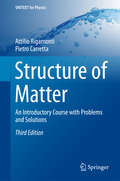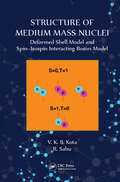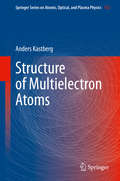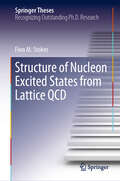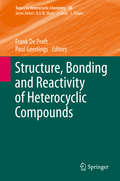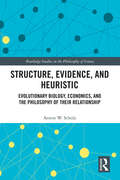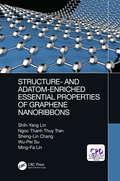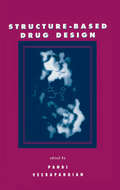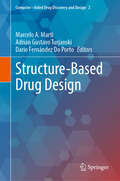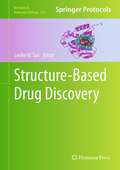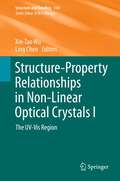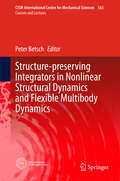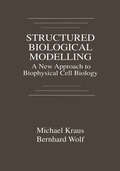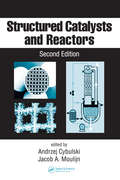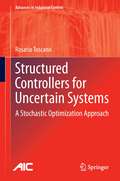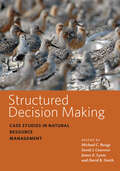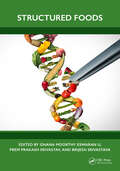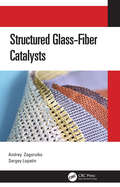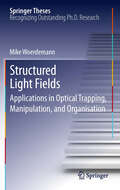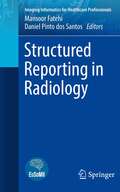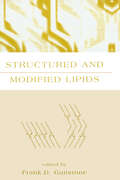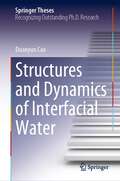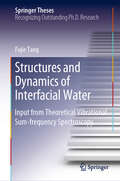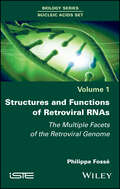- Table View
- List View
Structure of Matter
by Attilio Rigamonti Pietro CarrettaThis textbook, now in its third edition, provides a formative introduction to the structure of matter that will serve as a sound basis for students proceeding to more complex courses, thus bridging the gap between elementary physics and topics pertaining to research activities. The focus is deliberately limited to key concepts of atoms, molecules and solids, examining the basic structural aspects without paying detailed attention to the related properties. For many topics the aim has been to start from the beginning and to guide the reader to the threshold of advanced research. This edition includes four new chapters dealing with relevant phases of solid matter (magnetic, electric and superconductive) and the related phase transitions. The book is based on a mixture of theory and solved problems that are integrated into the formal presentation of the arguments. Readers will find it invaluable in enabling them to acquire basic knowledge in the wide and wonderful field of condensed matter and to understand how phenomenological properties originate from the microscopic, quantum features of nature.
Structure of Medium Mass Nuclei: Deformed Shell Model and Spin-Isospin Interacting Boson Model
by V K Kota R SahuMedium heavy nuclei with mass number A=60-90 exhibit a variety of complex collective properties, provide a laboratory for double beta decay studies, and are a region of all heavy N=Z nuclei. This book discusses these three aspects of nuclear structure using Deformed Shell Model and the Spin-Isospin Invariant Interacting Boson Model naturally generated by fermionic SO(8) symmetry. Using these two models, the book describes properties of medium heavy nuclei with mass number A=60-90. It provides a good reference for future nuclear structure experiments using radioactive ion beam (RIB) facilities. Various results obtained by the authors and other research groups are also explained in this book.
Structure of Multielectron Atoms (Springer Series on Atomic, Optical, and Plasma Physics #112)
by Anders KastbergThis book is about the structure of multielectron atoms and predominantly adopts a perturbative approach to the total Hamiltonian. A key concept is the central-field approximation and, beyond the standard LS-coupling and jj-coupling schemes, intermediate cases are also treated. After that, the book covers hyperfine structure and other nuclear effects, as well as interactions with static external fields. Throughout the book, an analytical approach is adopted. Working knowledge of basic quantum mechanics (including the non-relativistic hydrogen atom, basic angular momentum and perturbation theory) is assumed, and it begins with a brief recap of the hydrogen orbitals, before turning towards the symmetry aspects of multi-electron atoms, spin-orbit interaction and couplings of angular momenta.
Structure of Nucleon Excited States from Lattice QCD (Springer Theses)
by Finn M. StokesQuantum Chromodynamics (QCD) describes the interactions between elementary quarks and gluons as they compose the nucleons at the heart of atomic structure. The interactions give rise to complexity that can only be examined via numerical simulations on supercomputers. This work provides an introduction to the numerical simulations of lattice QCD and establishes new formalisms relevant to understanding the structure of nucleons and their excited states. The research opens with an examination of the non-trivial QCD vacuum and the emergence of “centre domains.” The focus then turns to establishing a novel Parity-Expanded Variational Analysis (PEVA) technique solving the important problem of isolating baryon states moving with finite momentum. This seminal work provides a foundation for future calculations of baryon properties. Implementation of the PEVA formalism discloses important systematic errors in conventional calculations and reveals the structure of nucleon excited states from the first principles of QCD for the first time.
Structure, Bonding and Reactivity of Heterocyclic Compounds
by Frank Proft Paul GeerlingsThe series Topics in Heterocyclic Chemistry presents critical reviews on present and future trends in the research of heterocyclic compounds. Overall the scope is to cover topics dealing with all areas within heterocyclic chemistry, both experimental and theoretical, of interest to the general heterocyclic chemistry community. The series consists of topic related volumes edited by renowned editors with contributions of experts in the field.
Structure, Evidence, and Heuristic: Evolutionary Biology, Economics, and the Philosophy of Their Relationship (Routledge Studies in the Philosophy of Science)
by Armin W. SchulzThis book is the first systematic treatment of the philosophy of science underlying evolutionary economics. It does not advocate an evolutionary approach towards economics, but rather assesses the epistemic value of appealing to evolutionary biology in economics more generally. The author divides work in evolutionary economics into three distinct, albeit related, forms: a structural form, an evidential form, and a heuristic form. He then analyzes five examples of work in evolutionary economics falling under these three forms. For the structural form, he examines the parallelism between natural selection and economic decision making, and the parallelism between natural selection and market competition. For the evidential form, he looks at the relationship between animal and human economic decision making, and the evolutionary explanation of diversity in human economic decision making. Finally, for the heuristic form, he focuses on the plausibility of equilibrium modeling in evolutionary ecology and economics. In this way, he shows that linking evolutionary biology and economics can make for a powerful methodological tool that can enable progress in our understanding of various economics questions. Structure, Evidence, and Heuristic will be of interest to scholars and advanced students working in philosophy of science, philosophy of social science, evolutionary biology, and economics.
Structure- and Adatom-Enriched Essential Properties of Graphene Nanoribbons
by Shih-Yang Lin Sheng-Lin Chang Wu-Pei Su Ming-Fa Lin Ngoc Thanh Thuy TranStructure- and Adatom-Enriched Essential Properties of Graphene Nanoribbons offers a systematic review of the feature-rich essential properties in emergent graphene nanoribbons, covering mainstream theoretical and experimental research. It includes a wide range of 1D systems; namely, armchair and zigzag graphene nanoribbons with and without hydrogen terminations, curved and zipped graphene nanoribbons, folded graphene nanoribbons, carbon nanoscrolls, bilayer graphene nanoribbons, edge-decorated graphene nanoribbons, and alkali-, halogen-, Al-, Ti, and Bi-absorbed graphene nanoribbons. Both multiorbital chemical bondings and spin arrangements, which are responsible for the diverse phenomena, are explored in detail. First-principles calculations are developed to thoroughly describe the physical, chemical, and material phenomena and concise images explain the fundamental properties. This book examines in detail the application and theory of graphene nanoribbons, offering a new perspective on up-to-date mainstream theoretical and experimental research.
Structure-Based Drug Design
by Pandi VeerapandianIntroducing the most recent advances in crystallography, nuclear magnetic resonance, molecular modeling techniques, and computational combinatorial chemistry, this unique, interdisciplinary reference explains the application of three-dimensional structural information in the design of pharmaceutical drugs. Furnishing authoritative analyses by world-renowned experts, Structure-Based Drug Design discusses protein structure-based design in optimizing HIV protease inhibitors and details the biochemical, genetic, and clinical data on HIV-1 reverse transcriptase presents recent results on the high-resolution three-dimensional structure of the catalytic core domain of HIV-1 integrase as a foundation for divergent combination therapy focuses on structure-based design strategies for uncovering receptor antagonists to treat inflammatory diseases demonstrates a systematic approach to the design of inhibitory compounds in cancer treatment reviews current knowledge on the Interleukin-1 (IL-1) system and progress in the development of IL-1 modulators describes the influence of structure-based methods in designing capsid-binding inhibitors for relief of the common cold and much more!
Structure-Based Drug Design (Computer-Aided Drug Discovery and Design #2)
by Marcelo A. Marti Adrian Gustavo Turjanski Dario Fernández Do PortoThis volume focuses on target-oriented approximations to drug discovery, including target selection, binding pocket detection, and current uses and variants of molecular dynamics and molecular docking. The primary audience is PhD and graduates working in the field of molecular biology, structural biology, pharmaceutical sciences.
Structure-Based Drug Discovery
by Leslie W. TariThe last decade has seen the confluence of several enabling technologies that have allowed protein crystallographic methods to live up to their true potential. Taken together, the numerous recent advances have made it possible to tackle difficult biological targets with a high probability of success: intact bacterial ribosomes have been structurally elucidated, as well as eukaryotic trans-membrane proteins like the potassium channel and GPCRs. It is now possible for medicinal chemists to have access to structural information on their latest small molecule candidates bound to the therapeutic target within days of compound synthesis, allowing structure guided ligand optimization to occur in "real time". Structure-Based Drug Discovery presents an array of methods used to generate crystal structures of biological macromolecules, how to leverage the structural information to design novel ligands anew, and how to iteratively optimize hits and convert them to leads. Written in the successful Methods in Molecular BiologyTM series format, chapters include introductions to their respective topics, lists of the necessary materials and reagents, step-by-step, readily reproducible protocols, and notes on troubleshooting and avoiding known pitfalls. Authoritative and easily accessible, Structure-Based Drug Discovery aims to provide scientists interested in adding SBDD to their arsenal of drug discovery methods with well-honed, up-to-date methodologies.
Structure-Property Relationships in Non-Linear Optical Crystals II
by Xin-Tao Wu Ling ChenXiao-Ming Jiang, Sheng-Ping Guo, Hui-Yi Zeng, Ming-Jian Zhang, Guo-Cong Guo: Large Crystal Growth and New Crystal Exploration of Mid-Infrared Second-Order Nonlinear Optical Materials.- Kechen Wu: Simulation and Design of Infrared Second-Order Nonlinear Optical Materials in Metal Cluster Compounds.- Chaoyang Tu: The Recent Development Of SRS and SRS SF- conversion Laser Crystal.- Hua-Jun Zhao, Xin-Tao Wu, Li-Ming Wu: Exploration of New Second-Order Nonlinear Optical Compounds Containing Main Group Elements.
Structure-preserving Integrators in Nonlinear Structural Dynamics and Flexible Multibody Dynamics
by Peter BetschThis book focuses on structure-preserving numerical methodsfor flexible multibody dynamics, including nonlinear elastodynamics andgeometrically exact models for beams and shells. It also deals with the newlyemerging class of variational integrators as well as Lie-group integrators. Itdiscusses two alternative approaches to the discretization in space ofnonlinear beams and shells. Firstly, geometrically exact formulations, whichare typically used in the finite element community and, secondly, the absolutenodal coordinate formulation, which is popular in the multibody dynamicscommunity. Concerning the discretization in time, the energy-momentum methodand its energy-decaying variants are discussed. It also addresses a number ofissues that have arisen in the wake of the structure-preserving discretizationin space. Among them are the parameterization of finite rotations, theincorporation of algebraic constraints and the computer implementation of thevarious numerical methods. The practical application of structure-preservingmethods is illustrated by a number of examples dealing with, among others,nonlinear beams and shells, large deformation problems, long-term simulationsand coupled thermo-mechanical multibody systems. In addition it links novel timeintegration methods to frequently used methods in industrial multibody systemsimulation.
Structured Biological Modelling: A New Approach to Biophysical Cell Biology
by Bernhard Wolf Michael KrausStructured Biological Modelling presents a straightforward introduction for computer-aided analysis, mathematical modelling, and simulation of cell biological systems. This unique guide brings together the physiological, structural, molecular biological, and theoretical aspects of the signal transduction network that regulates growth and proliferation in normal and tumor cells. It provides comprehensive survey of functional and theoretical features of intracellular signal processing and introduces the concept of cellular self-organization. Exemplified by oscillatory calcium waves, strategies for the design of computer experiments are presented that can assist or even substitute for time-consuming biological experiments. The presented minimal model for proliferation-associated signal transduction clearly shows the alterations of the cellular signal network involved in neoplastic growth. This book will be useful to cell and molecular biologists, oncologists, physiologists, theoretical biologists, computer scientists, and all other researchers and students studying functional aspects of cellular signaling.
Structured Catalysts and Reactors (Chemical Industries)
by Jacob A. Moulijn Andrzej CybulskiInterest in structured catalysts is steadily increasing due to the already proven, as well as potential, advantages of these catalysts. Updating the comprehensive coverage of the first edition published in 1998 with the latest science and applications, Structured Catalysts and Reactors, Second Edition gives detailed information on all aspect
Structured Controllers for Uncertain Systems
by Rosario ToscanoStructured Controllers for Uncertain Systems focuses on the development of easy-to-use design strategies for robust low-order or fixed-structure controllers (particularly the industrially ubiquitous PID controller). These strategies are based on a recently-developed stochastic optimization method termed the "Heuristic Kalman Algorithm" (HKA) the use of which results in a simplified methodology that enables the solution of the structured control problem without a profusion of user-defined parameters. An overview of the main stochastic methods employable in the context of continuous non-convex optimization problems is also provided and various optimization criteria for the design of a structured controller are considered; H , H2, and mixed H2/H each merits a chapter to itself. Time-domain-performance specifications can be easily incorporated in the design.
Structured Decision Making: Case Studies in Natural Resource Management (Wildlife Management and Conservation)
by David R. SmithProvides and analyzes real examples of how structured decision making (SDM) can help solve complex problems involving natural resources.When faced with complicated, potentially controversial decisions that affect our environment, many resource management agencies have come to realize the value of structured decision making (SDM)—the systematic use of principles and tools of decision analysis. Few professionals, however, have extensive experience implementing SDM. Structured Decision Making provides key information to both current adopters of the method and those who are deploying it for the first time by demonstrating the formal use of decision analysis to support difficult, real-world natural resource management decisions. Drawing on case studies from multiple public agencies in the United States, Canada, Australia, and Mauritius, the editors present an overview of decision analysis, a classification of decision types, and a catalog of decision analysis methods. Dozens of detailed charts and maps help contextualize the material. These case studies examine a rich variety of topics, including• keeping forest birds free from disease• conserving imperiled freshwater mussels• managing water for oil sands mining• dealing with coastal wetlands in the face of sea-level rise• designing networks for prairie-dependent taxa• combatting invasive alpine shrubs• managing vernal pool habitats for obligate amphibian species • and much moreAimed at decision makers tackling natural resource challenges in government agencies around the world, as well as advanced undergraduate and graduate students preparing to work in natural resource management, Structured Decision Making shows how SDM can be implemented to achieve optimal outcomes that integrate social values and scientific understanding.Contributors: Taber D. Allison, Larissa L. Bailey, Ellen A. Bean, Clint W. Boal, Gregory Breese, Stefano Canessa, Jean Fitts Cochrane, Sarah J. Converse, Cami S. Dixon, John G. Ewen, Christelle Ferrière, Jill J. Gannon, Beth Gardner, Adam W. Green, Justin A. Gude, Victoria M. Hunt, Kevin S. Kalasz, Melinda G. Knutson, Jim Kraus, Graham Long, Eric V. Lonsdorf, James E. Lyons, Conor P. McGowan, Sarah E. McRae, Michael S. Mitchell, Clinton T. Moore, Joslin L. Moore, Steven Morey, Dan W. Ohlson, Charlie Pascoe, Andrew Paul, Eben H. Paxton, Lori B. Pruitt, Michael C. Runge, Sarah N. Sells, Terry L. Shaffer, Stephanie Slade, David R. Smith, Jennifer A. Szymanski, Terry Walshe, Nicolas Zuël
Structured Foods
by Prem Prakash Srivastav Eswaran U, Gnana Moorthy Brijesh SrivastavaStructured Foods is an important reference that discusses the recent research trends on structural development in various foods. This book covers different tools and food engineering techniques such as encapsulation, 3D and 4D printing, imaging techniques, and clean meat technology. It discusses how various foods can be broken down and manipulated at the molecular level to improve their quality, safety, and healthfulness. It describes the structuring of components like starch, proteins, and polysaccharides and the stability and bioavailability of different food structures. This is a useful reference for researchers and industry experts in food technology, food engineering, and food processing.The work addresses critical food-related issues that need to be tackled, including harvesting enough food to feed the global population, improving food sustainability, reducing food waste and pollution, and improving human health. Further, it focuses on the new scientific technologies being applied by scientists for an improved food system. The book is an important resource for all stakeholders in the debate about the future of our foods in the spheres of academic, industrial, and government policy.
Structured Glass-Fiber Catalysts
by Andrey Zagoruiko Sergey LopatinStructured Glass-Fiber Catalysts discusses the synthesis of advanced glass-fiber catalysts for various emerging applications, investigation of their properties, and development of the engineering basis required for their wide practical application. This book describes how to create and use such catalysts for different chemical reactions. It discusses how to efficiently arrange them into structured catalytic cartridges and gives examples of their successful application for purification of waste gases from different hazardous contaminants and environmentally safe combustion of fuels. It covers nanosize surface science fundamentals through large-scale commercial catalytic reactors. This book is aimed at researchers and engineers in the fields of chemical engineering, industrial engineering, and materials engineering.
Structured Light Fields
by Mike WördemannThe optical trapping of colloidal matter is an unequalled field of technology for enabling precise handling of particles on microscopic scales, solely by the force of light. Although the basic concept of optical tweezers, which are based on a single laser beam, has matured and found a vast number of exciting applications, in particular in the life sciences, there are strong demands for more sophisticated approaches. This thesis gives an introductory overview of existing optical micromanipulation techniques and reviews the state-of-the-art of the emerging field of structured light fields and their applications in optical trapping, micromanipulation, and organisation. The author presents established, and introduces novel concepts for the holographic and non-holographic shaping of a light field. A special emphasis of the work is the demonstration of advanced applications of the thus created structured light fields in optical micromanipulation, utilising various geometries and unconventional light propagation properties. While most of the concepts developed are demonstrated with artificial microscopic reference particles, the work concludes with a comprehensive demonstration of optical control and alignment of bacterial cells, and hierarchical supramolecular organisation utilising dedicated nanocontainer particles.
Structured Reporting in Radiology (Imaging Informatics for Healthcare Professionals)
by Mansoor Fatehi Daniel Pinto dos SantosThis book provides practitioners and scientists with insights into diverse aspects of structured reporting to allow them to develop tools and a knowledge base to ensure that this electronic reporting trend is widely applied. After an introduction to reporting in radiology, various parts of structured reporting are discussed in detail, including an overview of standardized reporting systems, standardized reporting language, DICOM structured reporting, template based structured reporting, and modular reporting. The last chapter addresses the interaction of structured reporting with artificial intelligence and its impact on the future of radiology. The last chapter addresses the interaction of structured reporting with artificial intelligence and its impact on the future of radiology. Endorsed by the European Society of Medical Imaging Informatics (EuSoMII), the scope of the book is based on the Medical Imaging Informatics sub-sections of the European Society of Radiology (ESR) European Training Curriculum Level I and II. It is a valuable resource for residents, radiologists and students.
Structured Singular Light Fields (Springer Theses)
by Eileen OtteStructured singular light is an ubiquitous phenomenon. It is not only created when light refracts at a water surface but can also be found in the blue daytime sky. Such light fields include a spatially varying amplitude, phase, or polarization, enabling the occurrence of optical singularities. As structurally stable units of the light field, these singularities are particularly interesting since they determine its topology. In this excellent book, the author presents a pioneering study of structured singular light, thereby contributing many original approaches. Especially in the field of polarization and its rich number of different types of singularities the book defines and drives a completely new field. The work demonstrates how to control complex polarization singularity networks and their propagation. Additionally, the author pioneers tightly focusing vectorial beams, also developing an urgently needed detection scheme for three-dimensional nanoscale polarization structures. She also studies classical spatial entanglement using structured light, introducing entanglement beating and paraxial spin-orbit-coupling. The book is hallmarked by its comprehensive and thorough way of describing a plethora of different approaches to structure light by amplitude, phase and polarization, as well as the important role of optical singularities.
Structured and Modified Lipids
by Frank D. GunstoneThis text addresses critical topics in the expanding market and production for lipids. It combines novel and traditional methods from technological and biological perspectives to achieve the most effective pathways for production of modified lipids. The book is organized into three sections exploring development, new production methods and successful products and uses.Structured and Modified Lipids provides a comprehensive exploration of issues related to lipids production and marketing. It combines novel and traditional methods from technological and biological perspectives to achieve the most effective pathways for production of modified lipids. The book is organized into three sections highlighting development, new production methods
Structures and Dynamics of Interfacial Water (Springer Theses)
by Duanyun CaoThis thesis highlights the study into the structures and dynamics of interfacial water, which is a cutting edge issue in condensed matter physics. Using the first principles calculation, classical molecular dynamics simulation and the simulation of atomic force microscopy (AFM), combined with the experimental results of AFM, the book systematically studies interfacial water at the atomic scale, especially the structure and growth mechanism of two-dimensional ice on hydrophobic Au (111) surface, the structure and the interconversion of the Eigen/Zundel hydrated proton on the Au(111) and Pt(111) surfaces, the microstructure and the hydration effect of the diffusion of ion hydrates on NaCl surface. This book displays the atomic scale information about the interaction between water and surface, and achieves many innovative results. Furthermore, the research methods included in this book can be further extended to study the more complex interfacial systems.
Structures and Dynamics of Interfacial Water: Input from Theoretical Vibrational Sum-frequency Spectroscopy (Springer Theses)
by Fujie TangThis book focuses on the study of the interfacial water using molecular dynamics simulation and experimental sum frequency generation spectroscopy. It proposes a new definition of the free O-H groups at water-air interface and presents research on the structure and dynamics of these groups. Furthermore, it discusses the exponential decay nature of the orientation distribution of the free O-H groups of interfacial water and ascribes the origin of the down pointing free O-H groups to the presence of capillary waves on the surface. It also describes how, based on this new definition, a maximum surface H-bond density of around 200 K at ice surface was found, as the maximum results from two competing effects. Lastly, the book discusses the absorption of water molecules at the water–TiO2 interface. Providing insights into the combination of molecular dynamics simulation and experimental sum frequency generation spectroscopy, it is a valuable resource for researchers in the field.
Structures and Functions of Retroviral RNAs: The Multiple Facets of the Retroviral Genome
by Philippe FosseOne family of viruses is responsible for the infection of many species of vertebrates. These are the retroviruses whose genomic RNA is used to support genetic information and ensures many essential functions that are required for the formation of an infectious viral particle. These functions depend on structures formed by the folding of the genomic RNA. Structures and Functions of Retroviral RNAs describes the formation of these structures and their specific interactions with nucleic acids and proteins. In light of recent advances in molecular virology, it provides an understanding of the various facets of the retroviral genome. It emphasizes in particular that the study of the structure–function relationship of retroviral RNAs is a driving force behind increased research into HIV-1, the main causal agent of AIDS. Indeed, one of the challenges of pharmacology lies in the exploitation of several targets which allow us to anticipate and stem the emergence of resistance to anti-HIV drugs. The book also presents structures and interactions that may be potential future targets in this regard.
